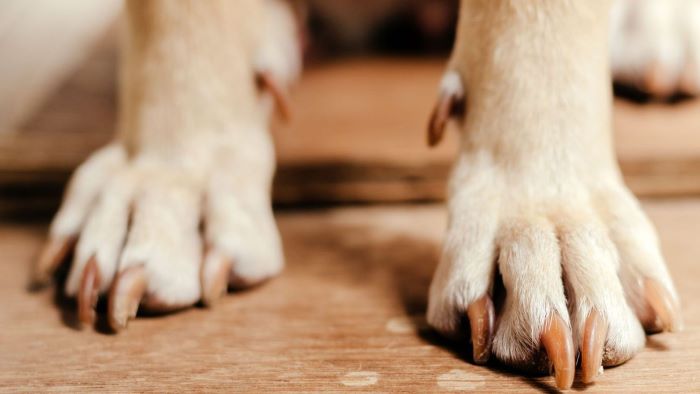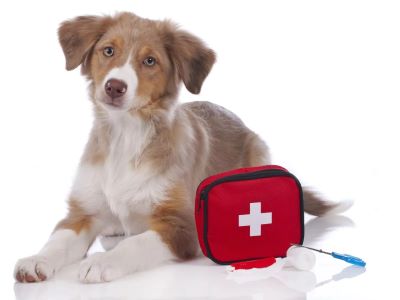It can be scary when you notice your dog’s nail is bleeding after a walk, play session, or nail trim. While mild bleeding may stop on its own, ongoing or heavy bleeding needs veterinary attention. There are several first-aid steps you can take at home to stop mild nail bleeding in dogs. With the right tips and prevention, you can also avoid future issues with bleeding nails.

How to Stop Dogs Nails from Bleeding?
If we want to learn how to stop dogs nails from bleeding, we should learn what causes their nails to bleed in the first place. The most probable causes of nail bleeding are:
Hitting the quick when trimming nails – The quick contains nerves and blood vessels. If you trim into this sensitive area, it can cause bleeding.
Nail injury from activity – Running, playing, hiking, etc. can cause nails to crack or tear, leading to bleeding. This is especially common in active dogs.
Nail infection – Bacterial or yeast infections in the nail bed can cause swelling, pain, and bleeding.
Nail tumours – Cancerous growths on the nail or digit can lead to bleeding.
Signs Your Dog’s Nail is Bleeding
How can you tell if your dog has a bleeding nail? Here are some signs that include:
- Bright red blood oozing from the nail. The may just be a few drops or a heavier flow.
- Licking and chewing at the paws. Your dog may instinctively try to clean and soothe their injured nail.
- Lameness. If the nail is very painful, your dog may avoid bearing weight on the affected paw.
When to See the Vet for Dog Nail Bleeding
While mild bleeding often resolves with home treatment, seek veterinary care if you feel the necessity. Here are some scenarios for you to see think How to Stop Dogs Nails from Bleeding?:
- There is heavy bleeding that won’t stop after 15-20 minutes of pressure.
- Your dog shows signs of nail infections like swelling, foul odour, or pus.
- Lameness lasts more than 1-2 days. This can signal a serious injury.
- Other concerning symptoms are present like loss of appetite, fever, or lethargy.
Veterinary assessment ensures proper treatment and pain control for injured nails.
First Aid Tips to Stop Mild Dog Nail Bleeding

For minor nail bleeding without other symptoms, try these first-aid steps:
Apply pressure – Gently press a clean cloth or tissue over the bleeding nail for 5-10 minutes. In many cases, this helps blood clot and stop bleeding. Apply constant firm pressure.
Use styptic powder or cornstarch – After applying pressure, dip the nail in styptic powder online or at pet stores.
Bandage the paw – Once bleeding slows, wrap the paw in gauze or a light bandage. This protects the nail and applies gentle pressure. Leave it on for a few hours.
Tips for Trimming Dog Nails to Avoid Bleeding
With some care, you can avoid clipping the quick when trimming your dog’s nails at home:
- Take your time and don’t rush the process. Give your dog treats and praise to keep them calm.
- Only trim off a small amount of the nail at a time. Cutting too much increases quicking risk.
- Use the right nail clipper for your dog’s size. Ensure it has sharp, precise blades.
- Having someone help hold and soothe your dog makes nail trims easier.
- Stop if you see a dark circle inside the nail, which is quick. It’s time to switch to a nail file instead.
Caring for an Injured Dog Nail at Home
If your dog cracks a nail, provide at-home care to help it heal:
- Gently clean dirt from the nail with soap and water, then apply antibiotic ointment.
- Wrap gauze or tape around the injured nail to cushion it, changing the bandage daily.
- Limit activities like running or climbing that can bump or snag the tender nail while it heals.
- Give pain medication like baby aspirin if your vet recommends it.
- See the vet if you notice signs of infection like swelling, heat, oozing, or a bad odour.
Preventing Future Nail Bleeding in Dogs
You can take proactive steps to avoid dealing with bleeding nails down the road:
- Do regular nail trims to keep your dog’s nails short and avoid overgrowth near the quick.
- After trimming, use a nail file to smooth any sharp edges left behind.
- Apply a pet-safe styptic gel like Kwik Stop after each nail trim as a precaution.
- Exercise your dog on softer surfaces like grass when possible, rather than rougher pavement that can crack nails.
- Check nails periodically for any abnormalities like new lumps, splits, or infections.
When to Seek Veterinary Care for Dog Nail Issues
You should contact your vet if these dog nail issues occur as an emergency to stop any further bleeding:
- Your dog’s nail shows signs of infection – redness, swelling, heat, pus, foul odour, etc.
- Bleeding won’t stop after 15-20 minutes of sustained, firm pressure.
- Persistent lameness lasts more than 1-2 days after the nail injury.
- You notice any lumps, deformities, or discolouration that could signal a tumour.
Vets have additional medications and tools to properly treat infected, damaged, or abnormal nails. They can provide pain control, remove damaged tissue, and give antibiotics are needed.
Veterinary Treatments for Dog Nails Problems

Depending on the underlying cause, vets may recommend:
Medications – To treat nail infections, antibiotics, antifungals, etc.
Surgery – To remove cancerous tumours or severely injured nail tissues.
Nail removal – If the damage is extensive, it may be best to fully remove the affected nail.
Other treatments – Medicated soaks, laser therapy, radiographs, biopsy, etc.
Referral – To a veterinary surgeon for specialized care if needed.
FAQs
How to Stop Dogs Nails from Bleeding?
Seek urgent vet care if the bleeding lasts more than 15-20 minutes despite pressure, or if you notice signs like dizziness, pale gums, a racing pulse, or collapse. These signal dangerous blood loss.
What home remedy helps stop dog nail bleeding?
Applying firm, constant pressure with a cloth or tissue for 5-10 minutes encourages natural clotting in most cases of mild bleeding. Styptic powder and bandaging also help control nail bleeding at home.
Can I use flour or baking soda to stop my dog’s nail from bleeding?
It’s safest to stick with commercial styptic powder approved for pets. Makeshift options like flour or baking soda can cause complications and don’t control bleeding as well.
What should I do for my dog’s cracked, bleeding nail?
Clean it gently, apply antibiotic ointment, and wrap the paw in gauze/tape for protection. Limit activity while it heals, and watch for signs of infection. See the vet promptly if you notice any warning signs.
Why does my dog’s nail sometimes bleed when I trim it?
This happens if you inadvertently trim into the quick, which has nerves and blood vessels. Go slower next time, trim less at once, and have a helper restrain your dog for safety. Switch to a file if you see the quick.
Conclusion
While scary, mild dog nail bleeding often stops with simple first aid at home. Ensure you know like warning signs that warrant an urgent vet visit. With some care-taking preventive measures, you can hopefully avoid dealing with bleeding nails in the future. Keep an out for any other abnormalities, and don’t hesitate to consult your vet about any concerns.
Reference:
- How to Stop Dogs Nails From Bleeding | petMD



